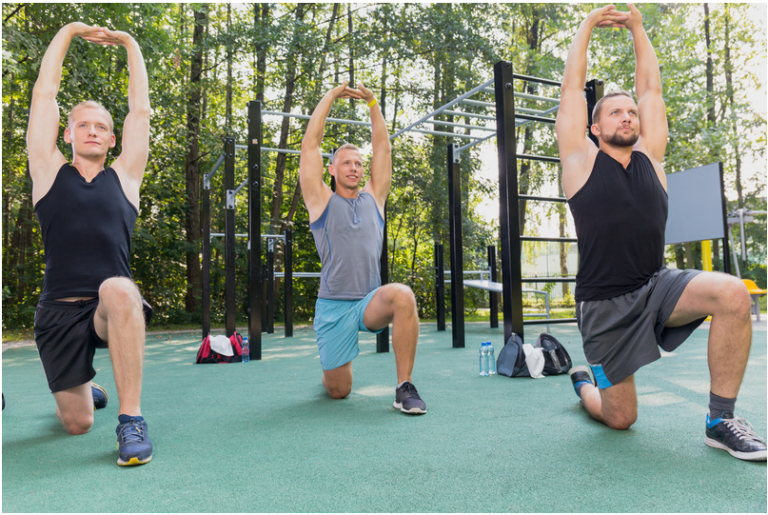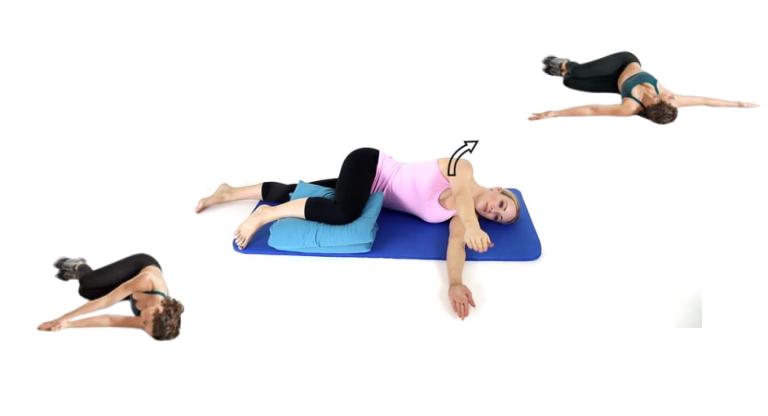
Teres Major Stretching: for Better Shoulder Mobility and Flexibility

The teres major is a small but important muscle that helps stabilize the shoulder joint and assist in arm movements. It originates from the lower border of the scapula (shoulder blade) and inserts into the humerus (upper arm bone). It works together with the latissimus dorsi (the largest muscle in the back) to perform adduction (bringing the arm closer to the body) and internal rotation (turning the arm inward) of the shoulder.
If the teres major muscle is tight or overworked, it can cause discomfort in the upper back, shoulder, and arm and limit the range of motion and mobility of the shoulder joint. This can affect your ability to perform daily activities, such as reaching overhead, lifting objects, or swimming. Stretching the teres major muscle can help to improve its flexibility and reduce pain and tension in the surrounding areas.
In this article, we will show you how to stretch the teres major muscle effectively and safely using simple yet effective exercises you can do at home or in the gym. We will also explain the benefits of stretching the teres major muscle and some tips and precautions to keep in mind. Following this guide can improve your shoulder health and well-being and prevent injuries and discomfort.
What are the benefits of stretching the teres major muscle?
Stretching the teres major muscle can provide several benefits for your shoulder health and overall well-being, such as:
- Improving the shoulder joint’s mobility and flexibility allows you to perform a wider range of arm movements and activities with ease and comfort.
- Reducing pain and tension in the upper back, shoulder, and arm by relaxing the tight and overworked muscle fibers and improving blood circulation to the area.
- Preventing injuries and inflammation in the shoulder joint and rotator cuff by maintaining the proper alignment and balance of the shoulder muscles and bones.
- Enhancing your posture and appearance by preventing the shoulder from drooping or rounding forward, which can cause a hunched or slouched look,
How do I stretch the teres major muscle effectively?
There are many ways to stretch the teres major muscle effectively, depending on your preference, fitness level, and equipment availability. Here are some of the most common and easy-to-do exercises that target the teres major muscle:
Cross-body stretch

You can do This simple and effective stretch anywhere, anytime. It involves crossing your arm over your chest and gently pulling it towards your opposite shoulder until you feel a stretch in the back of your shoulder and upper arm.
To perform this stretch, follow these steps:
- Stand with your feet shoulder-width apart and your back straight.
- Lift your right arm and bring it across your chest, parallel to the floor.
- Use your left hand to gently pull your right arm closer to your left shoulder until you feel a stretch in the back of your right shoulder and upper arm. You can also use a wall, a door frame, or a pole to assist you in this stretch.
- Hold this position for 30 seconds, breathing deeply and relaxing your muscles.
- Repeat on the other side.
Overhead stretch

This is another simple and effective stretch you can do anywhere. It involves reaching your arm overhead and bending your elbow, then using your opposite hand to gently pull your elbow behind your head until you feel a stretch in the back of your shoulder and upper arm.
To perform this stretch, follow these steps:
- Stand with your feet shoulder-width apart and your back straight.
- Lift your right arm and reach it overhead, bending your elbow at a 90-degree angle.
- Use your left hand to gently pull your right elbow behind your head until you feel a stretch in the back of your right shoulder and upper arm.
- Hold this position for 30 seconds, breathing deeply and relaxing your muscles.
- Repeat on the other side.
Ball Stretch
This more advanced and intense stretch requires a ball, such as a tennis ball, a lacrosse ball, or a foam roller. It involves placing the ball under your teres major muscle, near the lower border of your scapula, and applying pressure to it with your body weight until you feel a deep stretch.
To perform this stretch, follow these steps:
- Lie on your back on a mat or a firm surface, with your knees bent and your feet flat on the floor.
- Place the ball under your right shoulder blade, near the lower border of your scapula, where your teres major muscle is.
- Lift your right arm and reach it overhead, bending your elbow at a 90-degree angle.
- Slowly lower your torso onto the ball, using your left arm and leg to support you and control the intensity of the pressure.
- Roll the ball around the area until you find a spot where you feel a deep stretch in your teres major muscle. You may also feel some discomfort or pain, which is normal and indicates that you are releasing the tightness and tension in the muscle.
- Hold this position for 30 seconds, breathing deeply and relaxing your muscles.
- Repeat on the other side.
What tips and precautions to remember when stretching the teres major muscle?
Stretching the teres major muscle can benefit your shoulder health and well-being, but it also requires some care and attention to avoid injuries and complications. Here are some tips and precautions to keep in mind when stretching the teres major muscle:
- Warm up before stretching by doing light cardio or dynamic movements, such as arm circles, shoulder rolls, or swings, to increase blood flow and prepare your muscles and joints for stretching.
- Stretch gently and gradually, starting with low intensity and duration and increasing them as you feel more comfortable and flexible. Do not force or bounce the stretch, as this can cause damage to the muscle fibers and connective tissues.
- Listen to your body and stop if you feel any sharp or severe pain, numbness, tingling, or loss of function in your shoulder or arm. These could be signs of an injury or a medical condition that requires immediate attention.
- Consult your doctor or a physical therapist before stretching if you have any existing shoulder injuries or conditions, such as a rotator cuff tear, a shoulder dislocation, or a shoulder impingement syndrome. Some stretches may be contraindicated or need to be modified for your specific case.
Summary
The teres major is a small but important muscle that helps stabilize the shoulder joint and assist in arm movements. It can become tight or overworked due to various factors, such as poor posture, repetitive motions, or a lack of exercise, which can cause discomfort, pain, and limited mobility in the shoulder and arm.
Stretching the teres major muscle can help improve its flexibility, reduce pain and tension in the surrounding areas, and prevent injuries and inflammation in the shoulder joint and rotator cuff. There are many ways to stretch the teres major muscle effectively and safely using simple yet effective exercises that you can do at home or in the gym, such as the cross-body stretch, the overhead stretch, and the ball stretch.
However, it is important to follow some tips and precautions to avoid injuries and complications, such as warming up before stretching, stretching gently and gradually, listening to your body and stopping if you feel any pain, and consulting your doctor or a physical therapist before stretching if you have any existing shoulder injuries or conditions.
Here are some of the most important things to remember when stretching the teres major muscle:
- Stretching the teres major muscle can improve your shoulder mobility and flexibility, reduce pain and tension in the upper back, shoulder, and arm, prevent injuries and inflammation in the shoulder joint and rotator cuff, and enhance your posture and appearance.
- There are many ways to stretch the tere’s major muscle effectively and safely, such as the cross-body stretch, the overhead stretch, and the ball stretch, which involve different positions and levels of intensity.
- Warm up before stretching, stretch gently and gradually, listen to your body stop if you feel any pain, and consult your doctor or a physical therapist before stretching if you have any existing shoulder injuries or conditions.
References
- Jiménez-del-Barrio, S., Jiménez-Rejano, J.J., Rebollo-Salas, M., Mingo-Gómez, M.T., Lorenzo-Muñoz, A. and Ceballos-Laita, L., 2023. Increased Tone and Stiffness of the Teres Major Muscle in Elite Handball Athletes: A Cross-Sectional Study. Applied Sciences, 13(14), p. 84571
- Baek, C.H., Kim, B.T., Kim, J.G. and Kim, S.J., 2024. Increased latissimus dorsi and teres major muscle volume after anterior transfer for irreparable anterior superior rotator cuff tear: correlation with improved internal rotation strength. Archives of Orthopaedic and Trauma Surgery
- Stretch.com, 2023. Teres Major Stretch: 5 Effective Moves. [online] Available at: 3
- Kenhub, 2023. Teres major muscle: anatomy, function, clinical aspects. [online] Available at: 4



